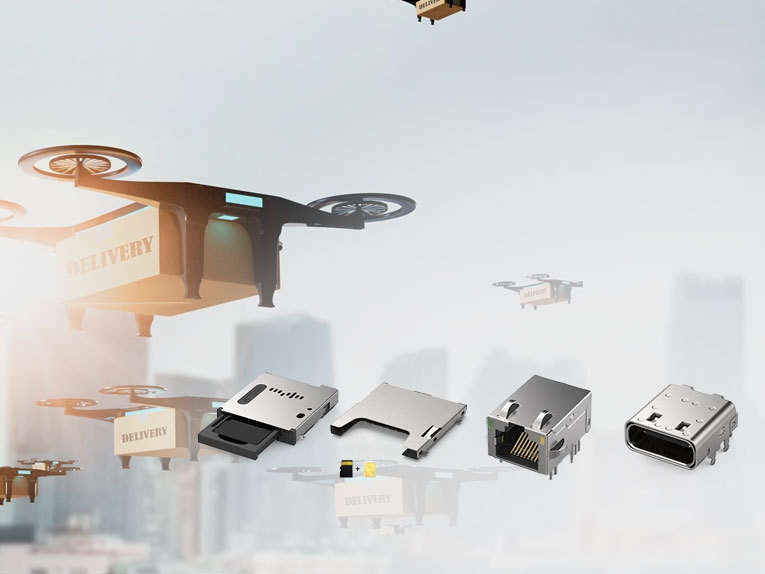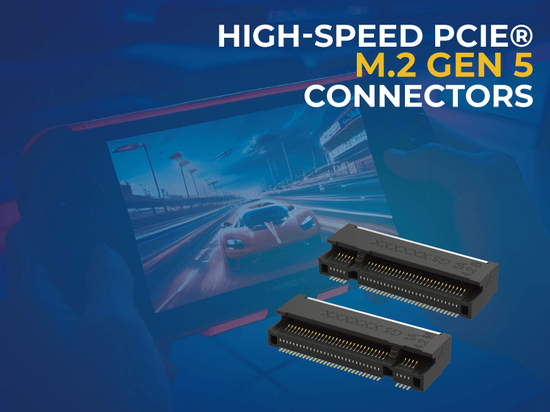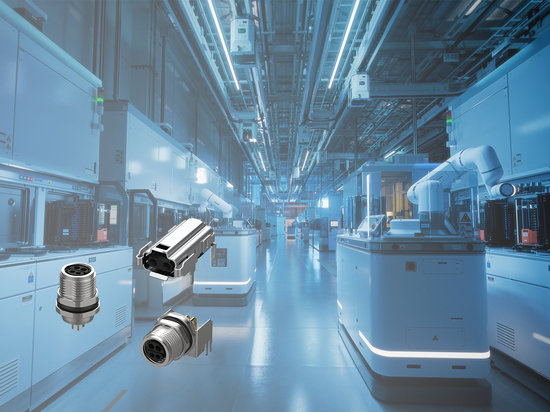
#White Papers
Connectivity Solutions for UAVs: Enabling Reliable and Robust Drone Applications
Development of Drone Technology
Drone Technology Revolution: Driving Industry Progress and New Applications
Development of Drone Technology
The rapid development of the drone industry has expanded its applications from recreational uses to aerial photography, surveillance, logistics, agricultural monitoring, infrastructure inspection, and emergency rescue. These diverse applications demonstrate the potential of drones across various sectors, fueling rapid market growth. According to a recent market analysis, the commercial drone market exceeded USD 26 billion last year and is expected to grow to nearly USD 150 billion by 2032, reflecting a compound annual growth rate (CAGR) of over 20%. This growth signifies both technological advancements in drone technology and the broad market demand for its applications.
Modern unmanned aerial vehicles (UAVs) operate increasingly complex environments, requiring stable and efficient components to ensure flight stability and performance. For example, in agriculture, drones enable precise crop monitoring, assisting farmers in managing their fields; in infrastructure inspection, drones can be used to inspect bridges, power towers, and pipelines, increasing inspection efficiency while reducing risks to personnel; logistics applications enable the rapid delivery of packages to remote areas, achieving swift delivery.
In these applications, connectors play a crucial role in power supply, data transmission, and signal integrity. With the emergence of advanced applications such as Beyond Visual Line of Sight (BVLOS) operations and Automatic Dependent Surveillance-Broadcast (ADS-B), selecting the right connectors has become increasingly important. These connectors must operate in harsh environments and support high-speed data transmission to meet the diverse needs of modern drones, thus supporting the industry’s continuous growth and innovative applications.
Hardware Requirements and Applications: UAVs and GCS
Unmanned Aerial Vehicles (UAVs):
UAVs are aircraft capable of flying without direct human control, relying on remote operators or automated flight control systems. They find broad applications in military surveillance, industrial inspections, and consumer uses like aerial photography. Technological advancements have expanded UAV applications from basic Visual Line of Sight (VLOS) operations to more challenging BVLOS missions. To meet these application requirements, UAVs utilize various connectors to ensure stability and reliability in their functions.
Ground Control Stations (GCS):
The GCS is a core component of UAV operations, responsible for monitoring and controlling UAV flights, including displays, control interfaces, communication modules, and data processing units. Its primary functions are to receive real-time UAV data, display flight information, send control commands, and exchange data with other systems. These functions require different connectors and SIM cards to ensure stable connections, such as:
SIM Card Connectors: Used for connecting GCS to cellular networks, enabling remote data transmission and control via 4G/5G networks, especially in dynamic geographic environments. ATTEND’s SIM Card Socket Series offers a comprehensive range of Mini SIM, Micro SIM, and Nano SIM options, with types including Hinge, Bar-Push, Dual SIM Push-Pull, and Flip-Top options. The Nano SIM sockets feature EMI shielding, ensuring reliable connectivity and durability across diverse environments.
RJ45 Ethernet Connectors: Support wired network connections, ideal for applications that require high-speed, low-latency data transmission, such as real-time video feedback, ensuring smooth data flow. ATTEND’s RJ45 Connector Series is ruggedized for industrial use, supporting various PoE standards, including PoE++, and available in shielded and unshielded versions to meet different EMI requirements, delivering stable, efficient network connectivity.
USB Type-C Connectors: Used to connect controllers, keyboards, displays, and other peripherals, offering flexibility and supporting data transmission and charging while ensuring compatibility with various devices. ATTEND’s USB Type-C Connector Series supports USB 3.1 Gen 2 speeds, offering data transfer rates up to 10 Gbps, ideal for high-resolution camera interfaces. The series includes various mounting styles for different PCB designs, with certain models featuring waterproof designs for use in harsh environments.
microSD Connectors: Extend GCS storage, enabling the recording of flight data and video to ensure sufficient storage capacity for critical data. ATTEND’s 112 Series microSD Card Sockets support default speed, high-speed, and UHS-I bus interface modes, offering data transfer speeds up to 104 MByte/s. They are compatible with SD, SDHC, SDXC, and SDUC formats and are widely used in industrial cameras, embedded systems, and IoT devices. Available in push-push, push-pull, reverse, and hinge types, they accommodate various design needs for compact electronics.
SMA Connectors: Connect GCS antennas, providing stable communication with drones over long distances, especially in BVLOS missions, enhancing signal strength and stability. ATTEND’s High-Performance RF Cable Assemblies include MMCX, SMA, and MHF interfaces, designed for a range of applications such as wireless infrastructure, military and aerospace, and RF testing. The MMCX series offers both straight and right-angle orientations, ensuring flexibility and compatibility for diverse industrial uses, with exceptional signal integrity and durability.
Battery/Pogo Pin Connectors: Used in GCS battery management systems, providing stable power supply, ensuring long operation time, and supporting quick battery replacement. ATTEND’s Battery Connector Series features flexible designs supporting 2.5 mm pitch sizes, multiple pin configurations, and stack heights. With a durability rating of 5,000 mating cycles, these connectors offer enhanced mechanical performance and longevity. Suitable for applications ranging from consumer electronics to industrial equipment, they ensure reliable electrical connections and consistent power delivery.
The integration of SIM cards allows GCS to maintain connectivity in different environments, particularly when Wi-Fi or wired networks are unstable. Using cellular networks for remote control and data transmission can significantly enhance operational flexibility.
Technical Requirements: BVLOS and ADS-B
Beyond Visual Line of Sight (BVLOS):
BVLOS allows UAVs to fly beyond the operator’s line of sight, enabling longer-range missions like remote surveillance and logistics delivery. This capability allows drones to cover wider areas without needing the operator to maintain visual contact. BVLOS is particularly valuable for large-scale agricultural monitoring or delivery of packages to remote locations. However, a stable long-range data link is required to ensure continuous data connection between the UAV and GCS, avoiding signal interruptions. BVLOS technical requirements include:
Stable Data Link: Connectors and SIM cards must ensure signal stability during long-distance transmission, supporting real-time video feedback, telemetry data, and command transmission.
Durable Design: UAVs often face various environmental conditions, and connectors must withstand extreme temperatures, humidity, and high-vibration environments to ensure stable operation.
Automatic Dependent Surveillance-Broadcast (ADS-B):
ADS-B is a real-time surveillance system through which UAVs broadcast their location, flight altitude, and speed, sharing data with air traffic control and other aircraft. It is crucial for the safe integration of drones into shared airspace, especially during BVLOS operations. By transmitting real-time position data, ADS-B helps prevent collisions and enhances airspace safety, allowing drones to operate alongside manned aircraft safely. ADS-B technical requirements include:
High-Speed Data Transmission: Connectors need to support high-frequency data exchange to ensure the rapid sharing of real-time location data.
Low-Latency Communication: Ensures that the UAV’s real-time position information is swiftly transmitted to air traffic management systems, reducing risks caused by data delays.
Market Trends and Future Prospects
As the adoption of autonomous drones and advancements in BVLOS technology continue, the demand for connectors that support long-range, high-performance data transmission is increasing. UAV designs are evolving towards more compact and efficient models, requiring connectors to be lightweight and capable of high-speed data transmission. Simultaneously, the application of ADS-B technology raises the requirements for stable, high-speed communication capabilities in connectors.
Impact of Drones on Military and Commercial Applications
In certain conflicts involving drone warfare, drones have been used for damage assessment, target tracking, and weapon delivery. Both sides have invested heavily in purchasing quadcopter drones. While these devices are relatively simple, their ability to navigate autonomously in GPS-denied environments has become increasingly critical. As conflicts progress, basic commercial drones are gradually being replaced by more efficient autonomous systems. Analysts indicate that the majority of drone investments are now focused on autonomous systems.
Military Applications:
Autonomous Navigation in Challenging Environments: The rise of these autonomous drones is driven mainly by artificial intelligence (AI) and machine learning (ML). These technologies enable drones to analyze data, identify patterns, and make independent decisions. This is particularly useful in GPS-jammed or hostile environments, where AI-based navigation helps drones traverse complex urban areas or hazardous war zones, improving flight planning efficiency and conserving battery life.
Intelligence, Surveillance, and Reconnaissance (ISR): Military drones are equipped for real-time surveillance, providing crucial aerial imagery and thermal data without risking human lives. This helps in strategic planning and gaining situational awareness on the battlefield.
Target Tracking and Damage Assessment: Drones are employed for precise tracking of enemy targets and, after airstrikes, are used to assess damage and verify mission success. This allows for better tactical decision-making and resource allocation.
Weapon Delivery and Tactical Strikes: Armed drones are capable of carrying out targeted strikes, delivering munitions with precision, and minimizing collateral damage. Their ability to be controlled remotely makes them valuable in modern warfare scenarios.
Commercial Applications:
Autonomous Delivery and Logistics: As autonomous capabilities develop, commercial applications like last-mile delivery have gained traction. Drones equipped with advanced navigation systems can deliver packages to remote or hard-to-reach areas, significantly reducing delivery times and costs.
Agricultural Monitoring and Precision Farming: Drones are extensively used in precision agriculture, where they gather data on crop health, soil conditions, and moisture levels through multispectral imaging, enabling farmers to optimize irrigation and fertilization.
Infrastructure Inspection and Maintenance: Drones offer a safer and more efficient alternative for inspecting critical infrastructure such as power lines, bridges, and pipelines. Equipped with high-resolution cameras and sensors, they can access hard-to-reach places, reducing the need for manual inspections.
Aerial Photography and Media Production: In the media industry, drones are used for capturing stunning aerial footage for movies, commercials, and real estate marketing, providing unique perspectives that were previously challenging or expensive to achieve.
Emergency Response and Disaster Relief: In disaster-affected areas, drones can quickly assess damage, locate survivors, and deliver essential supplies like medicine and food. Their ability to access areas cut off by natural disasters makes them invaluable for first responders.
The shift towards autonomous drones in both military and commercial sectors highlights the growing demand for systems that can operate with minimal human intervention. Military drones focus on enhancing tactical capabilities, while commercial drones leverage similar technologies to improve efficiency, reduce costs, and create new business opportunities across various industries.
Prospects and Challenges of Drone Delivery
Drone delivery holds significant potential for reducing transportation emissions and lessening reliance on traditional transportation methods. As e-commerce grows, the demand for delivery increases and lightweight package delivery is particularly suited for drone use. However, drone operations in urban areas raise privacy and data collection concerns, with critics worried that drones equipped with cameras and GPS navigation could infringe on privacy.
Nonetheless, drone delivery substantially shortens delivery times, allowing packages to reach homes or businesses in a fraction of the time required by traditional transportation methods, with the potential to redefine same-day delivery. Some companies plan to launch drone delivery services soon, with these trials aimed at collecting safety data to ensure the safe operation of drones in the airspace.
Drones as a Service (DaaS)
In recent years, several Drones-as-a-Service (DaaS) projects have been initiated, deploying drone units nationwide to support emergency response, perimeter security, and infrastructure inspection. These drones can be remotely operated, providing real-time information in emergencies. Such drone networks significantly enhance the efficiency of public safety emergency response.
Empowering the Future of Drones: Reliable Connectivity for Unmatched Performance
As drone technology evolves, the demand for stable, high-performance connectivity solutions becomes crucial. ATTEND Technology offers specialized connectors and cable solutions designed to meet the rigorous needs of modern UAVs and GCS systems, ensuring reliable operation even in challenging environments. Whether it’s for military applications, commercial logistics, or cutting-edge BVLOS operations, our products provide the stability and efficiency your drones require. Explore how ATTEND Technology’s solutions can elevate your drone’s capabilities—reach out to our team today to learn more.







